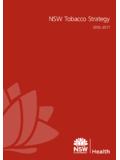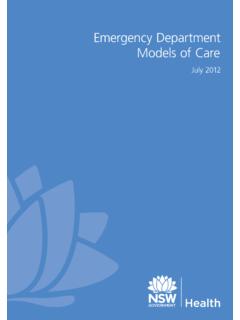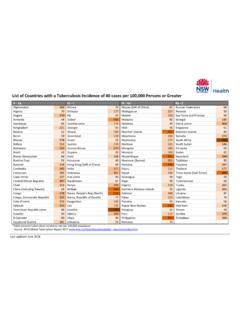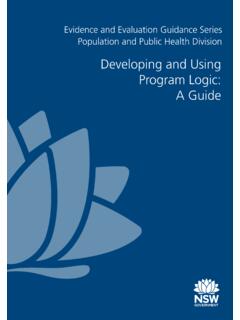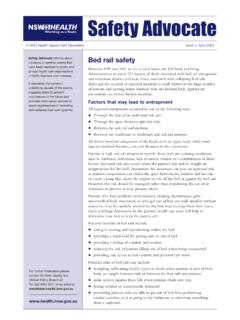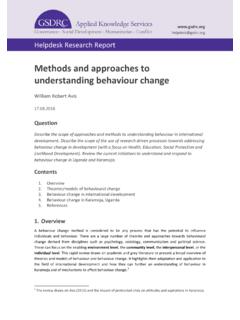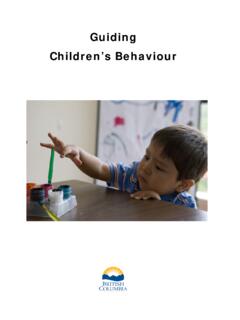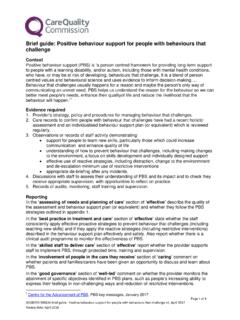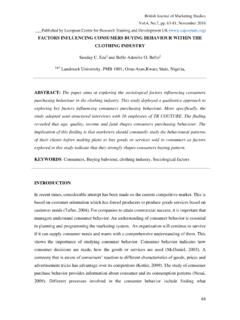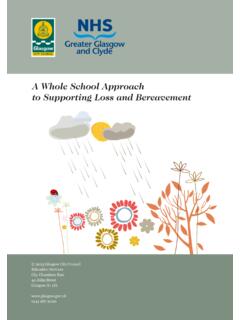Transcription of SECTION 3.3 UNDERSTANDING RISK TAKING BEHAVIOUR
1 SECTION 3 .3 UNDERSTANDING RISK TAKING BEHAVIOUR 79 UNDERSTANDING RISK TAKING BEHAVIOUR PETER CHOWN Most youth health problems are a consequence of risk- TAKING behaviours and exposure to social and environmental risk factors including accidents and injuries, substance use and mental health problems. It is important to understand, though, that risk- TAKING is a normal part of adolescent development: young people typically experiment with new behaviours as they explore their emerging identity and independence. While adults almost always view risk- TAKING in negative terms, not all risk- TAKING is dangerous or detrimental to a young person s health . In fact, a degree of risk- TAKING is essential for personal growth and development: it allows a young person to test their limits, learn new skills, develop competence and self-worth, and assume greater responsibility for their life (Clarke 2000).
2 Risk- TAKING BEHAVIOUR , however, is also central to the onset of many major youth health problems . Risk- TAKING BEHAVIOUR can be problematic and requires intervention when it: Interferes with normal youth development Poses serious risks to the young person s health and safety Impairs healthy functioning Becomes an established part of the young person s lifestyle Risk- TAKING BEHAVIOUR by young people poses an even greater threat when it is characterised by: Ignorance (lack of prior experience or adequate information) Impulsiveness and thrill-seeking Cognitive immaturity (the inability to compre hend the consequences of BEHAVIOUR ) Low self-worth and feelings of inadequacy Extreme risk- TAKING often indicates other issues, such as recent or past experience of being a victim of sexual and physical assault, bullying, or child abuse and neglect . Service providers can play a vital role in prevention and health promotion by using their consultations to: Screen for health risk factors in the young person s life through the HEEADSSS assessment Identify risk- TAKING behaviours the young person is engaged in Provide early intervention and health education appropriate to the developmental stage of the young person UNDERSTANDING RISK- TAKING For some young people, risk- TAKING is a way of resolving developmental challenges (for example, a young male who drinks heavily to prove that he is as grown-up as his peers).
3 For others, risk- TAKING may be a way of dealing with problems or escaping unhappy situations or feelings (such as a young woman who engages in sexual activity in response to her low self-esteem and feelings of worthlessness, or her experience of sexual assault) . While risk- TAKING BEHAVIOUR can constitute a major health problem in itself, it may also be an indicator of an underlying problem in the young person s life . Angry, acting-out BEHAVIOUR can mask depression, or it may reflect the young person s experience of violence . Risk- TAKING behaviours which can have serious negative implications for young people s health include: Early and/or high risk sexual activity Drink driving Substance or alcohol abuse Running away from home Dropping out of school Criminal activity Severe dieting Dissociation Suicidal thoughts and talk Self-harm Assaulting others SECTION Three - Chapter Three 81 PRACTICE POINT WHAT S NORMAL AND WHEN PRACTICE POINT WHAT S NORMAL AND WHEN TO WORRY TO WORRY Normal adolescent behaviours include: Worrying behaviours include.
4 Moodiness Wild mood swings Flare-ups Dramatic and/or persistent BEHAVIOUR change Open and talkative with friends, monosyllabic Isolation from peers with family Failing school performance or dropping out Actively striving for independence Violent or aggressive BEHAVIOUR Trying new experiences Dangerous drug and/or alcohol use To be like peers Loss of routine Sleeping in Excessive sleeping Critical and argumentative . Withdrawn, secretive or self-harming behaviours . SECTION Three - Chapter Three ASSESSING THE DANGER OF RISK- TAKING Risk assessment should take place in the context of UNDERSTANDING that the co-occurrence of health problems and risk- TAKING behaviours is prevalent in young people . It is also important to screen for trauma and domestic violence as these can have an effect on a young person s vulnerability . IDENTIFYING RISK AND PROTECTIVE FACTORS The degree of health risk attached to a young person s BEHAVIOUR depends in part on the balance of risk and protective factors in a young person s life (Sanci 2001).
5 The greater the number of risk factors present in a young person s life, the greater the likelihood that they will engage in risk- TAKING behaviours (Bond et al . 2000) . When screening for risk factors, it is also important to identify protective factors in the young person s life . Research has shown that protective factors can act as a buffer to the negative effects of risk factors and risk- TAKING behaviours (Bond et al . 2000) . The most powerful protective factors in reducing morbidity among young people are connectedness and belonging to family, school and peers (Resnick, Harris and Blum 1993) . A completed HEEADSSS assessment (see chapter 3 .2), provides you with profile of the balance of risk and protective factors in a young person s life see Table 4 (on the opposite page) . ASSESSING THE DEGREE OF RISK The more risk factors in a young person s life, the more likely they are to experience harmful conse quences from their risk- TAKING BEHAVIOUR .
6 When you are trying to determine the level of risk the young person faces, consider: The extent to which the BEHAVIOUR is compro mising the young person s safety, health and development . The range and severity of risk factors . The presence of one risk- TAKING BEHAVIOUR raises the risk of other risk- TAKING behaviours co-occurring (e .g . substance abuse combined with sexual risk- TAKING ; dropping out of school leading to the development of anti-social BEHAVIOUR ) (Bond et al . 2000) . The severity of the risk- TAKING BEHAVIOUR and whether it is escalating . The level of awareness the young person shows about the consequences of their BEHAVIOUR . The extent to which the BEHAVIOUR has become entrenched in the young person s lifestyle . Any strategies they use to minimise the harm associated with the risk BEHAVIOUR . The protective factors in the young person s life that might safeguard them against the conse quences of risk- TAKING behaviours .
7 When you have identified the risk and protective factors in the young person s life you can identify an overall risk status (Sanci 2001): 82 TABLE 4 RISK AND PROTECTIVE FACTORS Risk factors Characteristics of the young person and their social environment that increase their vulnerability to harm. Protective factors Individual and environmental factors that increase resistance to risk factors. Youth factors Low self-esteem Social competence Poor social skills Solid problem-solving skills Poor problem-solving skills Optimism Lack of empathy Good coping style Homelessness School achievement Diagnosed Attention Deficit Strong sense of moral values/spiritual beliefs Hyperactivity Disorder (ADHD) Creativity and imagination Non-adherence with health treatments Family factors Family conflict/breakdown/violence Harsh or inconsistent discipline Lack of warmth and affection Physical and/or sexual abuse and neglect Lack of meaningful relationships with adults Supportive, caring parents or carers Secure and stable family environment Supportive relationship with other adults Attachment to family School factors School failure or dropping out Positive school climate Bullying Pro-social peer group Peer rejection Positive achievements and sense Deviant peer group of belonging at school Learning difficulties Opportunities for some success (at sport, study etc.)
8 Or development of a special talent/hobby Recognition of achievement Community & Cultural factors Socio-economic disadvantage Exposure to violence and crime Homelessness Refugee experience Racism or discrimination Intercultural conflict (the young person trying to fit in and adapt to the new culture) Lack of support services Attachment and belonging to community Access to support services Participation in community group Strong cultural identity/pride Secure home/housing SECTION Three - Chapter Three 83 SECTION Three - Chapter Three TABLE 5 OVERALL RISK STATUS Risk level Description Characteristics Example No Risk Not yet engaged in risk- TAKING BEHAVIOUR Well-adjusted Family, school and social functioningare stable and positive Presence of a number of protective factorsLow Risk Engaged in experimentation Safe experimenter Risk- TAKING is sporadic, recrea tional and experimental Family, social and school profile is stable Protective factors outweigh risk behaviours May need monitoring if individual orenvironmental risk factors presentA young person who has experimented with marijuana with peers, but who has stable family and peer relationships.
9 And is doing well at school Moderate Risk Engaged in behav iours with harmful consequences ( impairment of positive functioning and developmental tasks) Vulnerable Presence of social/environmental risk factors(family problems, peer group influences;or other risk factors such as low self-esteemand family history of depression) Presence of some protective factors (suchas positive family, school or peer support) Requires interventionA depressed young person with low self-esteem and a family history of depression, who occasionally smokes marijuana by himself High Risk Major disruption or risk to health, safety or life Troubled or out-of-control Persistent and/or escalatingharmful behaviours Persistent and/or negative consequences( disruption of relationships, poorschool performance, trouble withpolice, conflict with family) Presence of major risk factorsand few protective factorsA young person who is involved in anti-social BEHAVIOUR , at risk of expulsion from school, with frequent alcohol and substance use, and with a lack of family support UNDERSTANDING THE EFFECTS OF TRAUMA Many young people with serious behavioural or emotional problems have experienced complex trauma in their childhood or adolescent devel opment.
10 Complex trauma refers to exposure to multiple and ongoing interpersonal stressors such as abuse, neglect or emotional or physical depri vation (Toro, Dworsky and Fowler 2007; Kezelman and Stavropoulos 2012) . This exposure often occurs within the family or another care-giving arrange ment that is supposed to be the source of stability and safety in a child s life . Research has highlighted the adverse effects of early onset trauma on the developing brain . Early onset trauma requires the brain to shift its focus from learning to survival and disrupts the neural integra tion necessary to respond flexibly to daily challenges (Courtois and Ford 2009) . The effects of complex trauma on individual functioning are pervasive and deeply disruptive to the key developmental of attachment, self-regulation and the development of competencies (Kezelman and Stavropoulos 2012; Siegel and Hartzell 2004).



